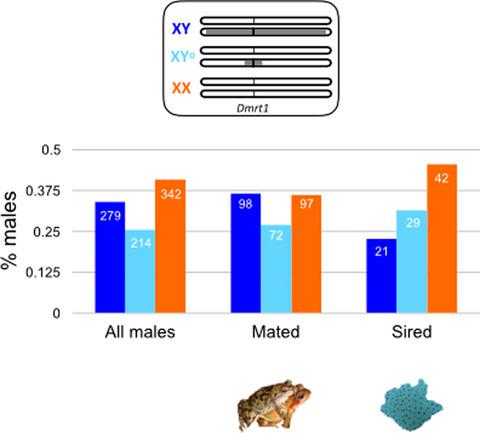当前位置:
X-MOL 学术
›
J. Evol. Biol.
›
论文详情
Our official English website, www.x-mol.net, welcomes your
feedback! (Note: you will need to create a separate account there.)
No evidence that Y-chromosome differentiation affects male fitness in a Swiss population of common frogs
Journal of Evolutionary Biology ( IF 2.1 ) Pub Date : 2019-12-20 , DOI: 10.1111/jeb.13573 Paris Veltsos 1 , Nicolas Rodrigues 1 , Tania Studer 1 , Wen-Juan Ma 1 , Roberto Sermier 1 , Julien Leuenberger 1 , Nicolas Perrin 1
Journal of Evolutionary Biology ( IF 2.1 ) Pub Date : 2019-12-20 , DOI: 10.1111/jeb.13573 Paris Veltsos 1 , Nicolas Rodrigues 1 , Tania Studer 1 , Wen-Juan Ma 1 , Roberto Sermier 1 , Julien Leuenberger 1 , Nicolas Perrin 1
Affiliation

|
The canonical model of sex‐chromosome evolution assigns a key role to sexually antagonistic (SA) genes on the arrest of recombination and ensuing degeneration of Y chromosomes. This assumption cannot be tested in organisms with highly differentiated sex chromosomes, such as mammals or birds, owing to the lack of polymorphism. Fixation of SA alleles, furthermore, might be the consequence rather than the cause of recombination arrest. Here we focus on a population of common frogs (Rana temporaria) where XY males with genetically differentiated Y chromosomes (nonrecombinant Y haplotypes) coexist with both XY° males with proto‐Y chromosomes (only differentiated from X chromosomes in the immediate vicinity of the candidate sex‐determining locus Dmrt1) and XX males with undifferentiated sex chromosomes (genetically identical to XX females). Our study finds no effect of sex‐chromosome differentiation on male phenotype, mating success or fathering success. Our conclusions rejoin genomic studies that found no differences in gene expression between XY, XY° and XX males. Sexual dimorphism in common frogs might result more from the differential expression of autosomal genes than from sex‐linked SA genes. Among‐male variance in sex‐chromosome differentiation seems better explained by a polymorphism in the penetrance of alleles at the sex locus, resulting in variable levels of sex reversal (and thus of X‐Y recombination in XY females), independent of sex‐linked SA genes.
中文翻译:

没有证据表明 Y 染色体分化会影响瑞士普通青蛙种群的雄性健康
性染色体进化的典型模型赋予性拮抗 (SA) 基因在阻止重组和随后 Y 染色体退化方面的关键作用。由于缺乏多态性,这种假设不能在具有高度分化的性染色体的生物体中进行测试,例如哺乳动物或鸟类。此外,SA 等位基因的固定可能是重组停滞的结果而不是原因。在这里,我们关注一个普通青蛙种群(Rana temporaria),其中具有遗传分化的 Y 染色体(非重组 Y 单倍型)的 XY 雄性与具有原始 Y 染色体的 XY° 雄性(仅与候选者附近的 X 染色体区分开来)共存。性别决定基因座 Dmrt1) 和具有未分化性染色体的 XX 雄性(与 XX 雌性遗传相同)。我们的研究发现性染色体分化对雄性表型、交配成功或父亲成功没有影响。我们的结论重新加入了基因组研究,该研究发现 XY、XY° 和 XX 男性之间的基因表达没有差异。普通青蛙的性别二态性可能更多地来自常染色体基因的差异表达,而不是来自性别相关的 SA 基因。性染色体分化的男性间差异似乎可以用性位点等位基因外显率的多态性更好地解释,导致性别逆转的不同水平(因此 XY 女性中的 X-Y 重组),与性相关SA基因。普通青蛙的性别二态性可能更多地来自常染色体基因的差异表达,而不是来自性别相关的 SA 基因。性染色体分化的男性间差异似乎可以用性位点等位基因外显率的多态性更好地解释,导致不同水平的性别反转(以及 XY 女性中的 X-Y 重组),与性别无关SA基因。普通青蛙的性别二态性可能更多地来自常染色体基因的差异表达,而不是来自性别相关的 SA 基因。性染色体分化的男性间差异似乎可以用性位点等位基因外显率的多态性更好地解释,导致不同水平的性别反转(以及 XY 女性中的 X-Y 重组),与性别无关SA基因。
更新日期:2019-12-20
中文翻译:

没有证据表明 Y 染色体分化会影响瑞士普通青蛙种群的雄性健康
性染色体进化的典型模型赋予性拮抗 (SA) 基因在阻止重组和随后 Y 染色体退化方面的关键作用。由于缺乏多态性,这种假设不能在具有高度分化的性染色体的生物体中进行测试,例如哺乳动物或鸟类。此外,SA 等位基因的固定可能是重组停滞的结果而不是原因。在这里,我们关注一个普通青蛙种群(Rana temporaria),其中具有遗传分化的 Y 染色体(非重组 Y 单倍型)的 XY 雄性与具有原始 Y 染色体的 XY° 雄性(仅与候选者附近的 X 染色体区分开来)共存。性别决定基因座 Dmrt1) 和具有未分化性染色体的 XX 雄性(与 XX 雌性遗传相同)。我们的研究发现性染色体分化对雄性表型、交配成功或父亲成功没有影响。我们的结论重新加入了基因组研究,该研究发现 XY、XY° 和 XX 男性之间的基因表达没有差异。普通青蛙的性别二态性可能更多地来自常染色体基因的差异表达,而不是来自性别相关的 SA 基因。性染色体分化的男性间差异似乎可以用性位点等位基因外显率的多态性更好地解释,导致性别逆转的不同水平(因此 XY 女性中的 X-Y 重组),与性相关SA基因。普通青蛙的性别二态性可能更多地来自常染色体基因的差异表达,而不是来自性别相关的 SA 基因。性染色体分化的男性间差异似乎可以用性位点等位基因外显率的多态性更好地解释,导致不同水平的性别反转(以及 XY 女性中的 X-Y 重组),与性别无关SA基因。普通青蛙的性别二态性可能更多地来自常染色体基因的差异表达,而不是来自性别相关的 SA 基因。性染色体分化的男性间差异似乎可以用性位点等位基因外显率的多态性更好地解释,导致不同水平的性别反转(以及 XY 女性中的 X-Y 重组),与性别无关SA基因。











































 京公网安备 11010802027423号
京公网安备 11010802027423号